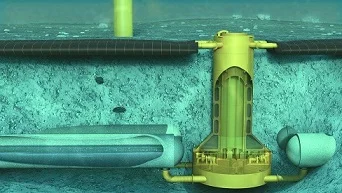Due to a shortage of storage, enough electricity to power almost one million homes was wasted in 2020.
The UK's offshore wind power capacity is expected to more than treble with 17 new wind farm projects planned for Scotland.
But what happens when the wind is blowing, the turbines are spinning, and there is no demand for electricity?
It has already become a problem. According to a survey commissioned by the power company Drax, enough electricity to power more than one million homes will be squandered due to a shortage of storage in 2020.
However, one company believes it has the answer, having won the 2022 Best of Innovation award at the CES technology exhibition earlier this year.
Ocean Grazer, a Dutch firm, has created the Ocean Battery, which stores energy beneath the wind farm.
When there is a surplus of electricity, the system pumps water from an underground reservoir into tough, flexible bladders on the seabed. You may compare them to large bicycle inner tubes.
Ocean Battery uses a bladder on the sea bed which holds water under pressure
The water in those tubes is under pressure, so when it is released the water flows quickly and is directed through turbines, also on the sea bed, generating electricity when needed.
"The Ocean Battery, is effectively based on the same technology as hydro storage, where water is pumped back through a dam in a river, though we have transformed it into something you can deploy on the sea bed," says chief executive Frits Bliek.
A protoype designed for deep water has already been tested at the port of Groningen in the Netherlands. The firm is now preparing to test a second system that has been modified for shallower water in a lake in the northern Netherlands. This should be operational next year.
Many on-shore wind farms already use batteries to store extra power but there are a number of problems when it comes to using these offshore.
"If you want to build a large-scale system offshore, you would also need to build a really huge platform built of sea containers and that's been found to be very, very costly. Also the lifetime of the batteries is not very long," says Mr Bliek.
Ocean Grazer's prototype being lowered into the water - it is now planning a bigger test
While lithium-ion batteries can last for 5,000-10,000 charging cycles, the Ocean Battery can take up to a million, he says. Though the cost of storage is roughly the same, this extended life makes it much cheaper overall.
"We found it can be built in shallow waters everywhere where wind farms are being built, and that's also pretty cost-effective at the end of the day," says Mr Bliek.
He also thinks the technology can be used alongside solar farms, if there is a lake nearby.
Dr Gavin Harper, Faraday Institution research fellow at Birmingham University, says the future of energy storage is likely to involve a mix of different techniques.
"Different energy storage technologies are suitable for storing energy on different time scales. Some are better suited for very fast responsive energy storage and others are suited to longer-term energy storage."
"One of the real advantages with this type of technology is it eliminates the use of critical materials - for example, cobalt, nickel and lithium - which are key technology metals used in the manufacture of lithium-ion batteries."
-black.png)










